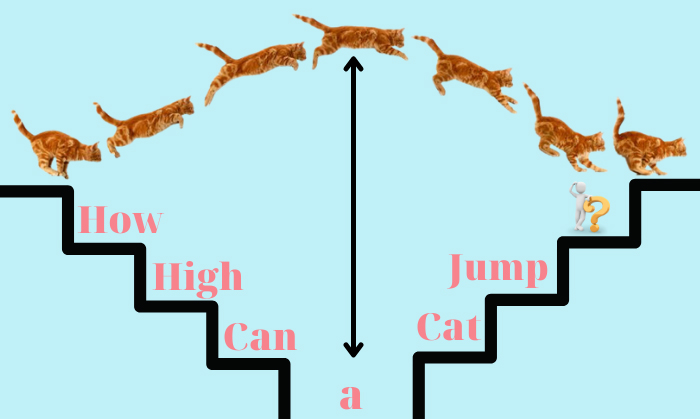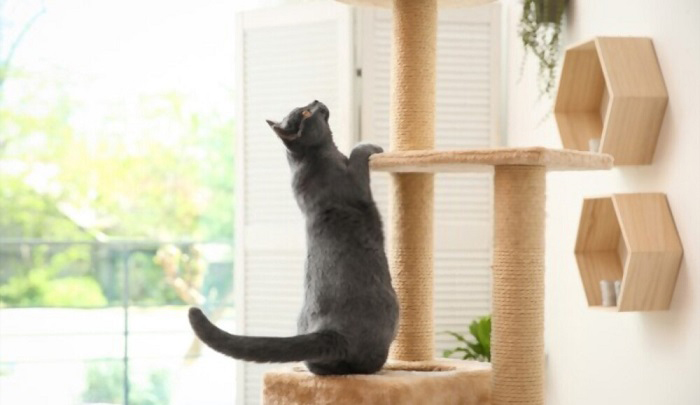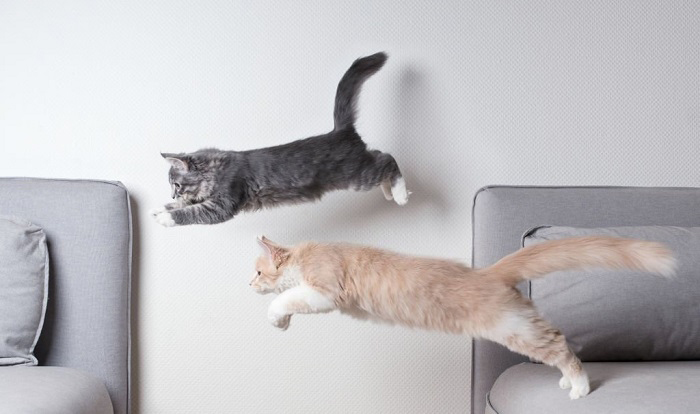Cats are designed to jump with their graceful hind legs, strong muscles, and great reflexes. Various factors such as age, weight, and breed can determine how high can a cat jump.
An adult cat, given its developed powerful back legs, can jump higher than kittens or old cats. On average, cats can jump for about 4-5 feet, which is five or six times the cat’s height. This is about 150-180cm.
Table of Contents
How Tall Can a Cat Jump?
A healthy cat’s jump height is 12 inches or 30cm, measured from the ground to their shoulders.
The average cat’s jump is up to six times their height. This translates between 59 inches or 150cm and 70.8 inches or 180cm.
You may wonder, “Can a cat jump a 6-foot fence?” This is possible as the animal can leap seven to eight times its height. The Guinness World Record documented the highest cat jump. For your information, the longest recorded cat jump record is 7 feet, held by Waffle the Warrior Cat in the US.
This is no surprise as cats are adept at jumping over—from stairs, baby gates, and garden fences to barricades and concrete dividers. They are also able to twist their bodies in the air to make a safe landing.
Why Can Cats Jump So High?
Cats jumping from high places start at an early age. Oftentimes, kittens jump around by the third week of life. They start with short objects like couches. Doing so strengthens their muscles and hones their jumping skills.
The hind limb length and fat mass of the cat help its ability to jump. As cats have slender bodies, their light weight allows them to increase muscle work. Similarly, those with longer hind limbs can effortlessly take off. In turn, these make it easier for the feline to leap better than, say, dogs.
Despite this innate ability, numerous factors can affect the cat’s jumping ability:
1. Age
Kittens and senior cats with arthritis cannot jump as high as their adult counterparts. The joints of their bones rub together, making it difficult to move. For older cats, this causes intense discomfort and swelling.
2. Hind limbs
How far can a cat spring from one place to another? The distance of a cat jump horizontally is mainly determined by the length of the limbs. The latter affects a cat:
- Efficiency
- Endurance
- Speed
- Jump Ability
- Takeoff Velocity (TOV)
This simply means how high or long an object travels after it leaves the ground. In the case of cats, their TOV relies on the length of their back legs and fat mass.
3. Fat mass relative to lean body mass
When a cat has more muscle mass and less fat, the cat’s ability to jump increases. Jumping requires muscle power. So, you may notice a domestic cat jump is higher than larger cats.ư
4. Overall health condition
Naturally, when a cat is healthy, it won’t have any difficulties moving and climbing elevated places. Their predatory instincts push them to move to areas where they can see everything. If they are in pain—whether physical or emotional—or have underlying medical conditions, these instincts and abilities are held back.
Why Do Cats Climb?
- It is a natural instinct
One of the cats’ ancestors, the African wildcat, sleeps in elevated areas. Modern-day domestic cats most likely carried this behavior as the feline evolved.
- It is stimulating
Climbing helps cats exercise—strengthening their muscles, challenging, and engaging them mentally. This explains a house cat jump activity rather than stay put so much.
- They want to see the whole environment and spot potential dangers.
As they are still vulnerable to larger predators, cats perch on high structures. This helps them hide their presence and easily escape from an incoming attack.
A house cat can jump as well as a way to find security. Guests or new people in the house can stress them out. Climbing to high areas like shelves and refrigerators helps them calm down.
- They jump and climb to hunt birds or any prey.
- They climb for fun or to improve their climbing activities.
Cats as Climbers
Unlike a dog, a cat is among the animals with this amazing ability to climb extraordinary heights. This is mainly for predatory or defensive reasons.
Using their strong hind legs, flexible spines, and rear claws for grip, they are able to jump, leap, and climb. This practice is beneficial to them as it strengthens their flexibility and helps them exercise their muscles.
Cat Jumping at Home
While this behavior is natural, it is essential to redirect the activities of your cat to appropriate areas within your home. Here are some veterinary guidance and suggestions:
- Cover the spaces your cat frequents with materials they do not like. An example is an aluminum foil or double-sided tape. Your cat will avoid these areas once it realizes the space is not pleasant to stay in.
- Buy a cat tree. This has poles and columns where your pets can climb, scratch, explore, and jump high as they please.
- Buy kitty condos. These are similar to cat trees but have resting and hiding places.
- Put a suction-cup perch on your window or glass patio door where your cat can leap up and enjoy the view outside.
- Put environmental deterrents that your cat does not like. But make sure these will not hurt them.
Conclusion
How high can a cat jump is dependent on the length of its legs and its fat mass. The leaner it is, the easier it can leap. In meters, a cat jump vertically distance reaching five to six times its height.
As long as it is healthy, most cats can jump nearly four feet and keep leaping and climbing trees and other structures. This helps it strengthen its muscles, the righting reflex, and exercise its instincts.
As a cat owner, it is your responsibility to allow your pet to do these. Even a senior cat still needs exercise. So, it is essential that you provide cat trees and keep your home clear of valuables like fragile vases in high places to avoid accidents.
Read more: How fast can a cat run?

I am Amy Sawy, a Doctor of Veterinary Medicine (DVM) graduate from the University of Kansas. y husband, Dr. Plummer, and I own a veterinary clinic in Phillipsburg, Kansas. In addition to my professional background, I am a devoted pet owner myself, with a household that includes dogs, rodents, and most notably, cats – a total of five felines in my home.
In 2020, I joined an organization as a professional writer, leveraging my experience and collaborating with my team to deliver the most valuable information for your cat’s care.














